Andrew Jones
Thu, November 9, 2023

Two cubesats sit on a table, gloved hands can be seen working on the farther.
Ireland is all set to see its first-ever satellite reach orbit.
The Educational Irish Research Satellite 1, or EIRSAT-1, was built by University College Dublin students as part of the European Space Agency (ESA) Academy's Fly Your Satellite! (FYS) program.
The gamma-ray astronomy cubesat project began in 2017 and is now due to fly on a SpaceX Falcon 9 rocket from Vandenberg Air Force Base in California at the end of November.
The two-unit cubesat carries three science payloads. The main payload is the Gamma-ray Module (GMOD), a detector that will study powerful gamma-ray bursts. The other two payloads will assess the performance of new protective oxide thermal coatings for satellites and test an alternative system for controlling spacecraft orientation called Wave Based Control.
Related: Cubesats: Tiny payloads, huge benefits for space research
"University College Dublin has immense expertise in the domains of space science of astrophysics, and with EIRSAT-1 they overcame the challenges of a very complex engineering project," Joost Vanreusel, head of the ESA Academy, said in an ESA statement.
"And that's what made it a very appealing project for the Fly Your Satellite! educational programme: the combination of the scientific expertise at the university with ESA's experience and expertise in the building and testing of small spacecraft," Vanreusel added.
The FYS program has allowed the students to work with ESA experts during design and development, and it will also support the full life cycle of a space mission. ESA also worked closely with Irish authorities to overcome the unique regulatory challenges posed by a country launching its first satellite.
The project has helped Ireland establish its first spacecraft operations procedures, while University College Dublin now also has space infrastructure in the form of a cleanroom and a mission control.
EIRSAT-1 was initially supposed to launch on an Arianespace Vega C rocket, then switched to the first flight of the much-delayed Ariane 6. It will now fly as a rideshare payload on a Falcon 9 rocket in late November.
1st black hole ever imaged by humans has twisted magnetic fields and scientists are thrilled
Robert Lea
Thu, November 9, 2023
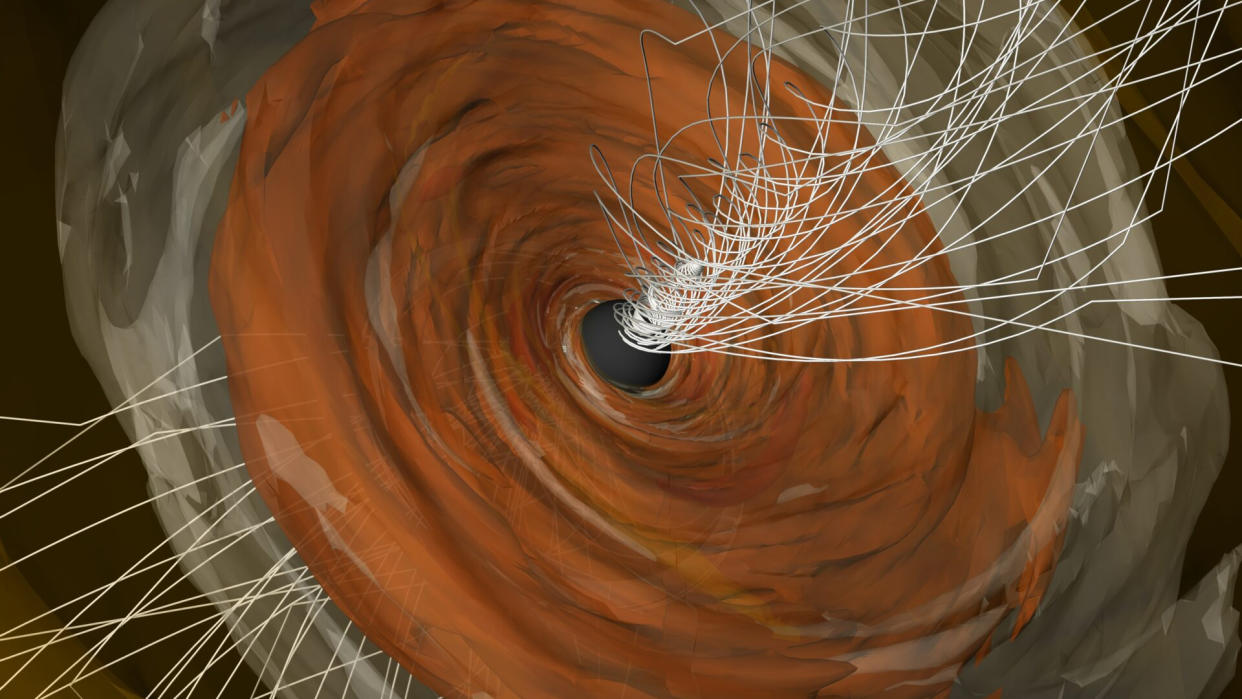
Twisted magnetic fields around the black hole at the heart of M87, shown in an illustration, may provide an escape route for matter from the immense gravitational well.
Spiraling light at the edge of a distant supermassive black hole could help matter escape from being consumed by this cosmic titan.
The supermassive black hole of M87 — also known as M87* — has a mass equal to around 6.5 billion suns. It especially came to the public's attention in 2019 when an image of M87*, captured by the Event Horizon Telescope (EHT), was the first glimpse of the surrounding environment of a black hole ever obtained by humanity.
Now, the EHT Collaboration, who was behind that historic image, have modeled the way the electric fields of light rotate around the supermassive black hole, which is located around 54 million light-years away from Earth. This polarized light, whose waves vibrate on a single plane, carries with it information about the magnetic field and the particles that are accelerated to near-light-speeds around the black hole.
Scientists now suggest those magnetic fields may deprive M87's monster black hole of a meal, instead launching this matter into space as highly collimated (or parallel) jets that blast out at almost the speed of light. The constantly rotating light around M87* is also known as circular polarization.
Related: 1st black hole imaged by humanity is confirmed to be spinning, study finds
"Circular polarization is the final signal we looked for in the EHT's first observations of the M87 black hole, and it (the polarization) was by far the hardest to analyze," Andrew Chael, study co-author and project coordinator at Princeton University, said in a statement.
"These new results give us confidence that our picture of a strong magnetic field permeating the hot gas surrounding the black hole is the right one," added Chael, an associate research scholar with the Princeton Gravity Initiative — which combines the university's astrophysics, mathematics and physics departments to seek the nature of gravity. "The unprecedented EHT observations are allowing us to answer long-standing questions," he added, "about how black holes consume matter and launch jets outside their host galaxies."
Two years after the release of the image of the supermassive black hole in M87, in 2021, the EHT Collaboration released a second stunning look. The newer image showed, for the very first time, polarized light around a black hole. (Polarized light has a different orientation and brightness than unpolarized light.) The 2021 data also revealed the direction of oscillating (vibrating) electric fields, providing the first hint that magnetic fields around M87* are strong and ordered.
Researchers next took a closer look using the Atacama Large Millimeter/submillimeter Array (ALMA) located in Northern Chile, which provided calibration by acting as a reference antenna for the EHT. ALMA is an array of 66 antennas in the Chilean desert that can peer through cosmic dusty environments, like black holes, to seek longer wavelengths of light.

Swirling golden gas and dust shows polarized magnetic fields around the supermassive black hole at the heart of M87, as seen in a composite image obtained by the Event Horizon Telescope in 2021.
ALMA is part of a network of EHT's radio telescopes around the world, which come together to create a virtual instrument the size of Earth. (The technique is also known as very long baseline interferometry, or VLBI).
The new analysis of the ALMA data, collected in 2017, shows how the electric fields of light twist around in a linear direction, once again providing evidence for the strong magnetic fields glimpsed in 2021. Using a computer simulation, the EHT scientists suggest these strong magnetic fields push back on matter that is falling toward M87*.
Related Stories:
— Star-birthing galaxies can hide supermassive black holes behind walls of dust
— How the Event Horizon Telescope hunts for black hole silhouettes
— Swirling gas helps scientists nail down Milky Way's supermassive black hole mass
The magnetic fields also launch jets of matter away from M87* at velocities near the speed of light before the matter passes through the black hole's event horizon — the point at which nothing can escape a black hole, even light — and add to the black holes already tremendous mass. (This means that the EHT cannot image black holes themselves, as they emit no light, but each black hole's surroundings do glow in detectable radiation.)
The researchers continue to analyze the data for stronger evidence of linear polarization, as they say their work could " still leave room for improvement," Hugo Messias, a study co-author who leads the VLBI team at ALMA, said in the same statement. "This circularly polarized light that has now been detected is very faint, but in more recent years, EHT has been observing with more stations and improved sensitivity — meaning that the ongoing analysis will likely provide us with new tips on the secrets around M87*."
The EHT Collaboration is collectively credited as the first author in the new EHT findings, which are detailed in a Wednesday (Nov. 8) paper published in the Astrophysical Journal.
X-37B Headed Deeper Into Space With Falcon Heavy Rocket's Help
Thomas Newdick
Thu, November 9, 2023
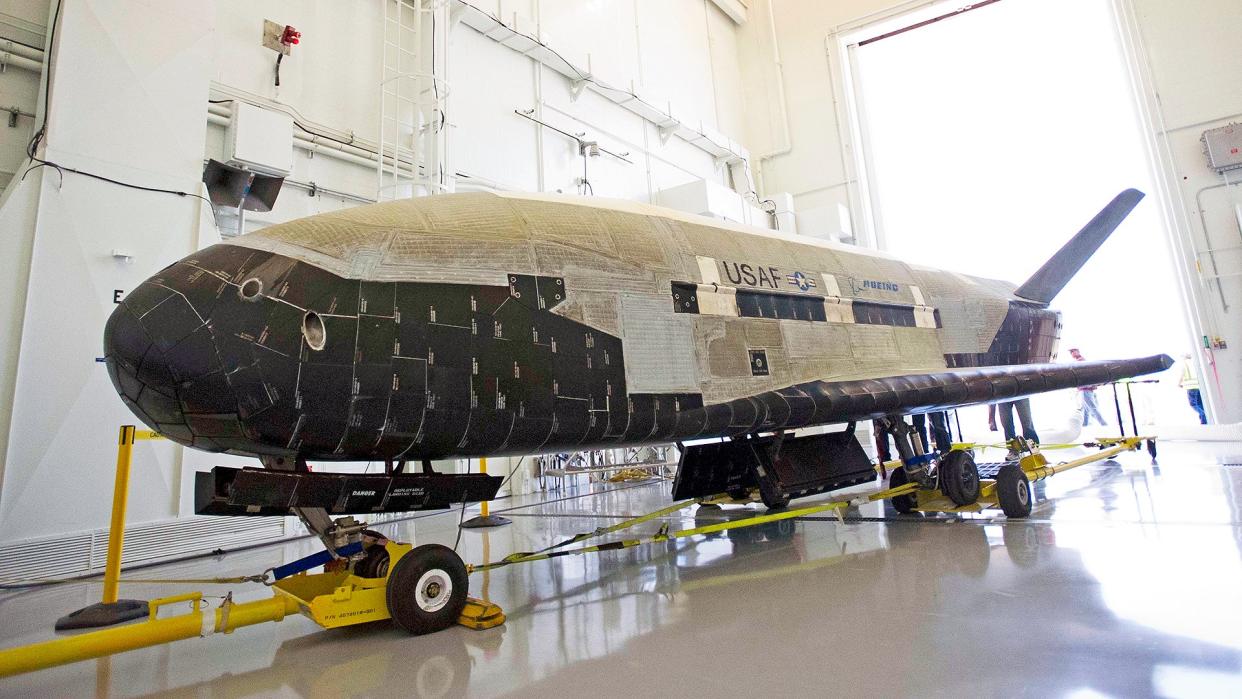
X-37B is heading into space on a Falcon heavy rocket.
The countdown is on for the next mission of the U.S. Space Force’s secretive X-37B spaceplane. While all of the X-37B’s missions so far have been highly intriguing, to say the least, the next one — the seventh — will involve some particular novelties. Not only will it explore what the Space Force describes as “new orbital regimes,” but the reusable spaceplane will ride atop a SpaceX Falcon Heavy rocket, the most powerful commercial rocket operational anywhere in the world, with the potential to put it much into much higher orbit than was possible on previous missions.
The Space Force announced yesterday that X-37B Mission 7 is scheduled to launch from the Kennedy Space Center, Florida, on December 7, 2023. The spaceplane’s first mission on a Falcon Heavy rocket will be designated USSF-52 and it will be run by the Space Force together with the Air Force Rapid Capabilities Office.
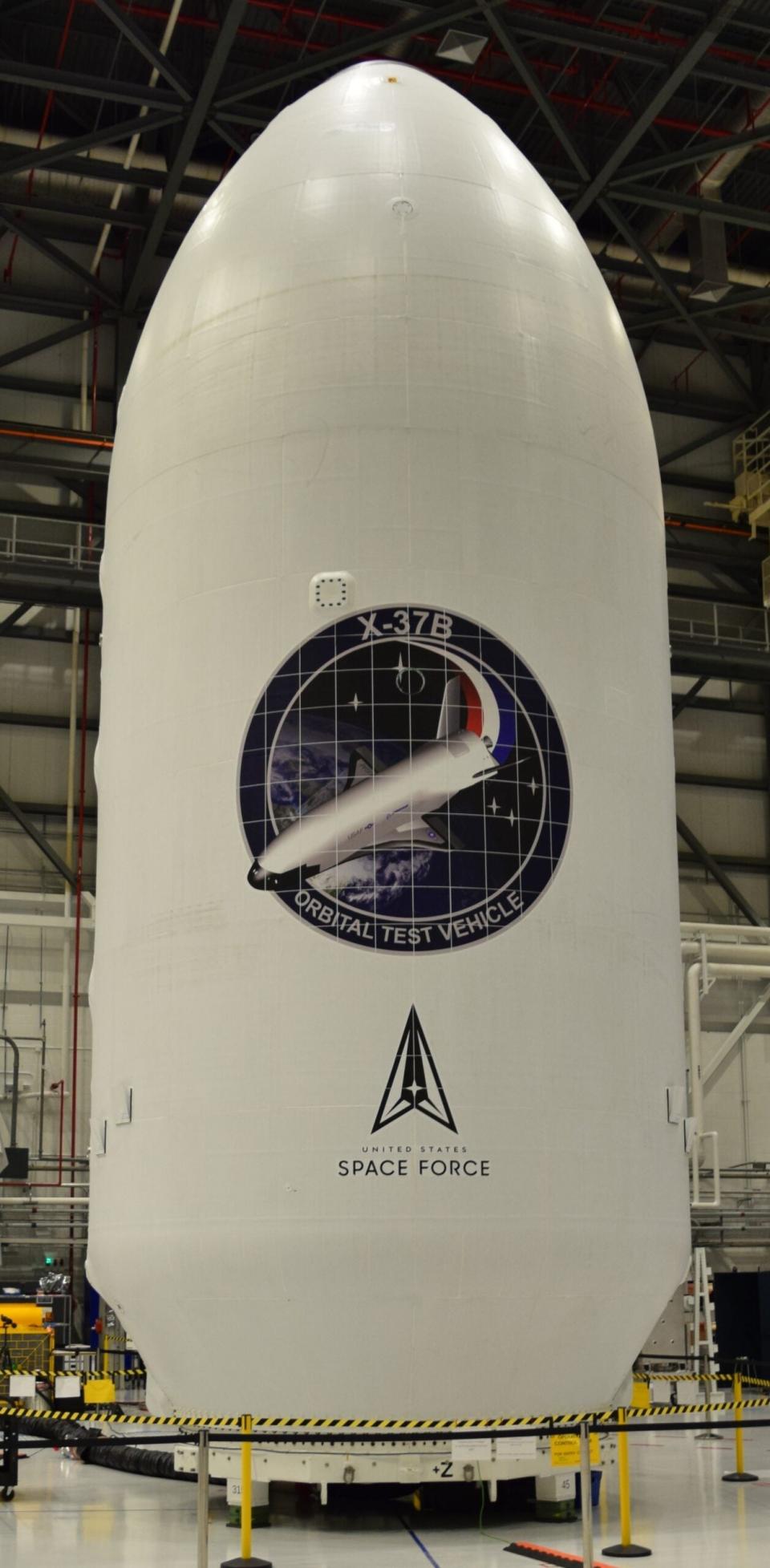
Featuring the U.S. Space Force (USSF) logo for the first time, the encapsulated X-37B Orbital Test Vehicle for the USSF-52 Mission. Boeing via USSF
In a typically tersely worded statement, the Space Force said that X-37B Mission 7 will have “a wide range of test and experimentation objectives.” It continued: “These tests include operating the reusable spaceplane in new orbital regimes, experimenting with future space domain awareness technologies, and investigating the radiation effects on materials provided by NASA.”
Lt. Col. Joseph Fritschen, the X-37B Program Director, added: “We are excited to expand the envelope of the reusable X-37B’s capabilities, using the flight-proven service module and Falcon Heavy rocket to fly multiple cutting-edge experiments for the Department of the Air Force and its partners.”
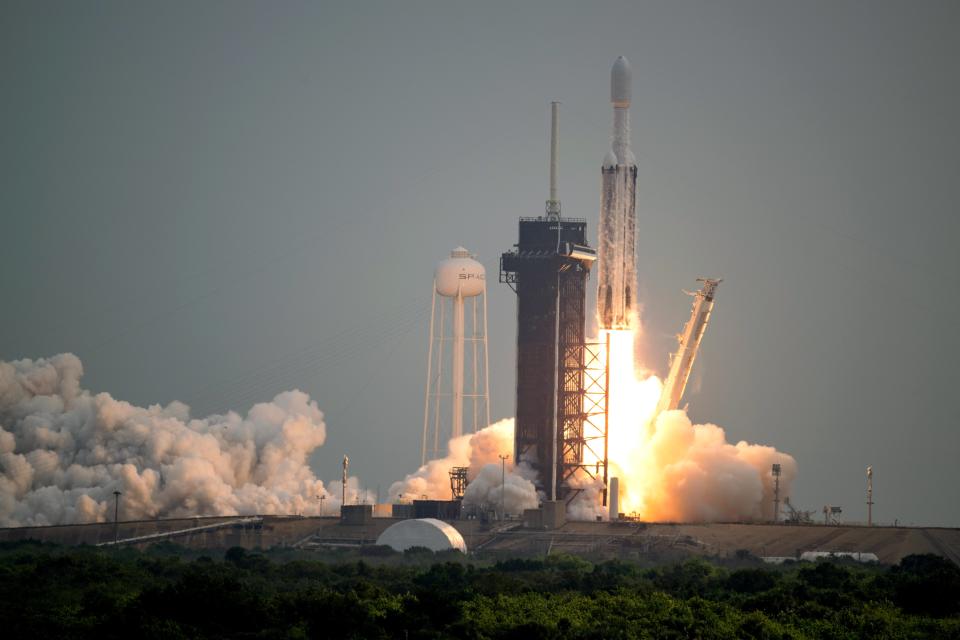
A SpaceX Falcon Heavy rocket with the Psyche spacecraft onboard is launched from Launch Complex 39A, on October 13, 2023, at the Kennedy Space Center in Cape Canaveral, Florida. Photo by Aubrey Gemignani/NASA via Getty Images
Until Wednesday, it wasn’t publicly known that the X-37B would be riding atop the Falcon Heavy rocket. Previously, the cargo involved in USSF-52 had not been revealed. That mission had originally been planned for launch back in 2021, after SpaceX received a $130-million contract for it in June 2018. It was delayed by what Space News described as “payload readiness and range scheduling issues.”
Using the Falcon Heavy rocket comes after six previous missions that employed the medium-lift Atlas V or Falcon 9 rockets.
https://twitter.com/newwavecosmos/status/1262069658292715521
There remains a big question over how exactly the spaceplane will be used differently after launch by the more powerful rocket. However, Falcon Heavy will be able to propel the X-37B into a higher orbit, which would also correspond with the statement about “new orbital regimes.”
According to the science and technology website Ars Technica, the original military solicitation document for the USSF-52 mission called for a lift capacity of around 14,000 pounds, delivering this into a geostationary transfer orbit. This kind of orbit involves a highly elliptical loop around Earth at a height of around 22,000 miles above sea level. The X-37B weighs around 11,000 pounds, minus the service module.
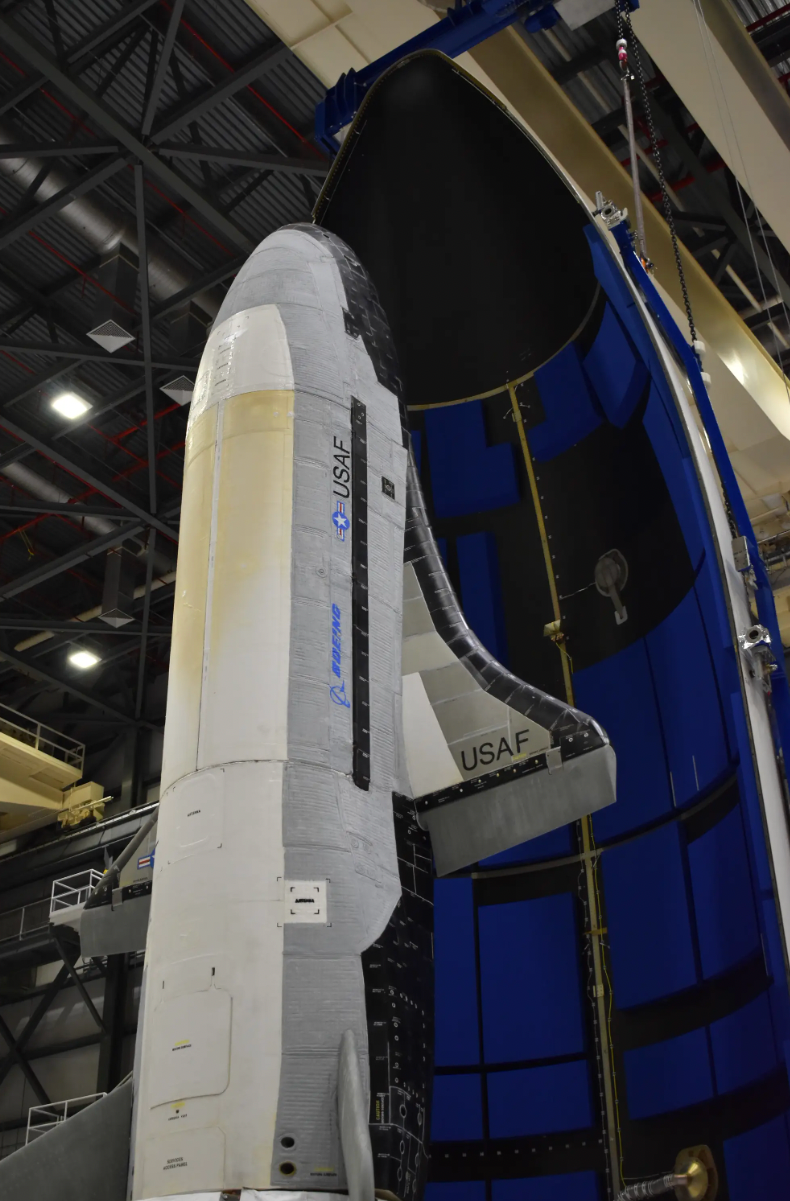
The X-37B, when still in U.S. Air Force markings. USAF
The previous six missions involved mid-inclination orbits, in which the X-37B flew a few hundred miles above the Earth, following a path that took the spaceplane between about 55 degrees north and south latitude on each orbit. This was in the realm of low earth orbit (LEO), which is roughly beneath a height of 1,200 miles above the surface of the planet. Many objects in LEO are at a few hundred miles or so in altitude. The International Space Station, for instance, orbits 254 miles above the planet.
However, as Ars Technica points out, with the solicitation document now being more than five years old, the requirements could have been updated to reflect changes in the mission. It’s possible, however, that more details could be revealed close to the launch, based on airspace and maritime warning notices.
The Space Force’s statement about using the X-37B “in new orbital regimes,” coupled with the use of the Falcon Heavy rocket on this mission ties in with some of what is known about the U.S. military’s ambitions as regards missions beyond traditional orbits, including in the space between these well established orbital planes and the moon, and possibly beyond.
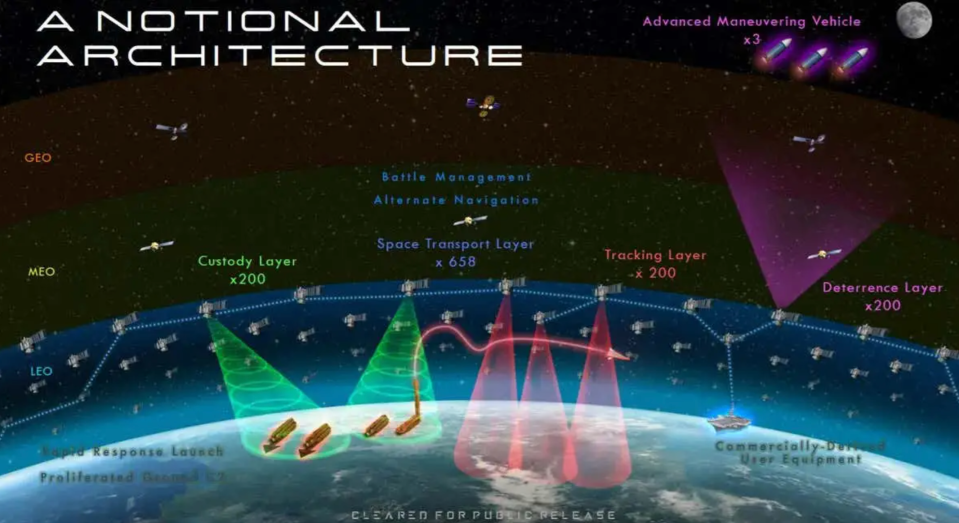
A Pentagon image shows satellite layers in different levels of orbit around the Earth. DoD
Back in 2020, The War Zone reported on how the Space Vehicles Directorate, part of the Air Force Research Laboratory (AFRL) was running an internal competition aimed at selecting a new project to explore potential military activities in new areas of space. This included efforts to examine missions in very low orbits around the Earth, but also operations in cislunar space between the Earth and the Moon.
“We in AFRL are working on technologies to expand space domain awareness above the GEO [geostationary] belt — so from the GEO belt all the way to the Moon and even a little bit beyond,” Air Force Col. Eric Felt, then the head of the Space Vehicles Directorate, said at the time. “It’s what we call the xGEO, or the cislunar, area of operations. And as commercial people move there, and our adversaries move there, that becomes an area where we need to know what’s going on up there.”
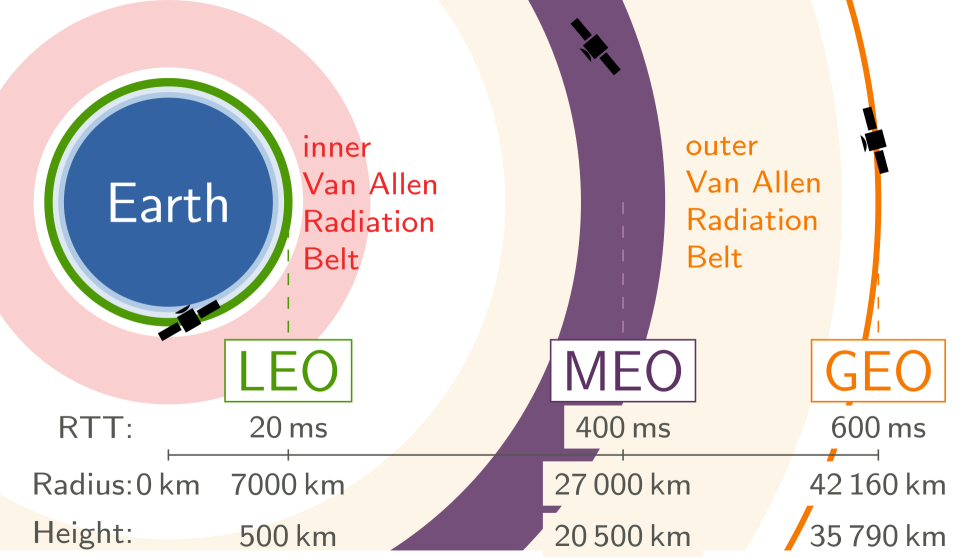
A graphic depicting the major different orbits around our planet, from low earth orbit (LEO), via medium earth orbit (MEO), to geostationary orbit (GEO). Sedrubal/Wikicommons
It’s noteworthy, too, that Col. Felt used the same term “space domain awareness” that the Space Force now does in its statement about the next X-37B mission.
Combining the X-37B with the Falcon Heavy rocket would seem to have particular relevance when operating in cislunar space, although in lower orbits the spaceplane configuration also brings advantages, including a significant degree of maneuverability, something that Air Force officials have referred to in the past.
Wherever exactly in space the Falcon Heavy rocket will take it, the X-37B will be packed with various items of equipment, for test work and possibly more.
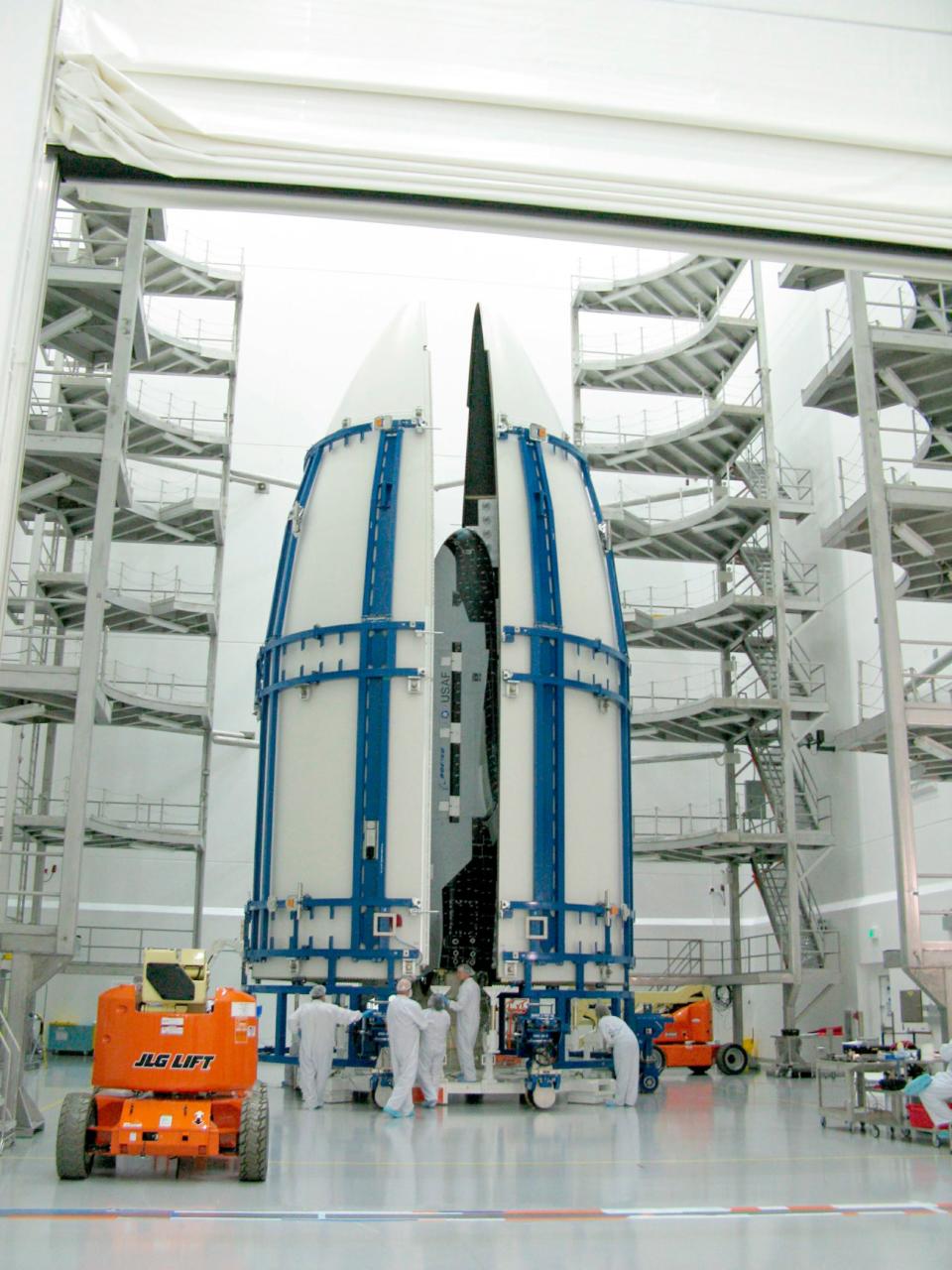
The X-37B during encapsulation within the United Launch Alliance Atlas V fairing, on February 8, 2011, at Astrotech in Titusville, Florida. Photo by DoD/Corbis via Getty Images
Referring to the mission’s planned experiments as “groundbreaking,” Chief of Space Operations, Gen. B. Chance Saltzman, said: “The X-37B continues to equip the United States with the knowledge to enhance current and future space operations. X-37B Mission 7 demonstrates the USSF’s commitment to innovation and defining the art of the possible in the space domain.”
Of those experiments, only the one on behalf of NASA has so far been described in any more detail. Known as Seeds-2, this onboard experiment “will expose plant seeds to the harsh radiation environment of long-duration spaceflight.” It’s a continuation of previous experiments and should help to pave the way for future crewed space missions.
As to the reference to “future space domain awareness technologies,” the Space Force says this part of the mission will involve tests that “are integral in ensuring safe, stable, and secure operations in space for all users of the domain.”
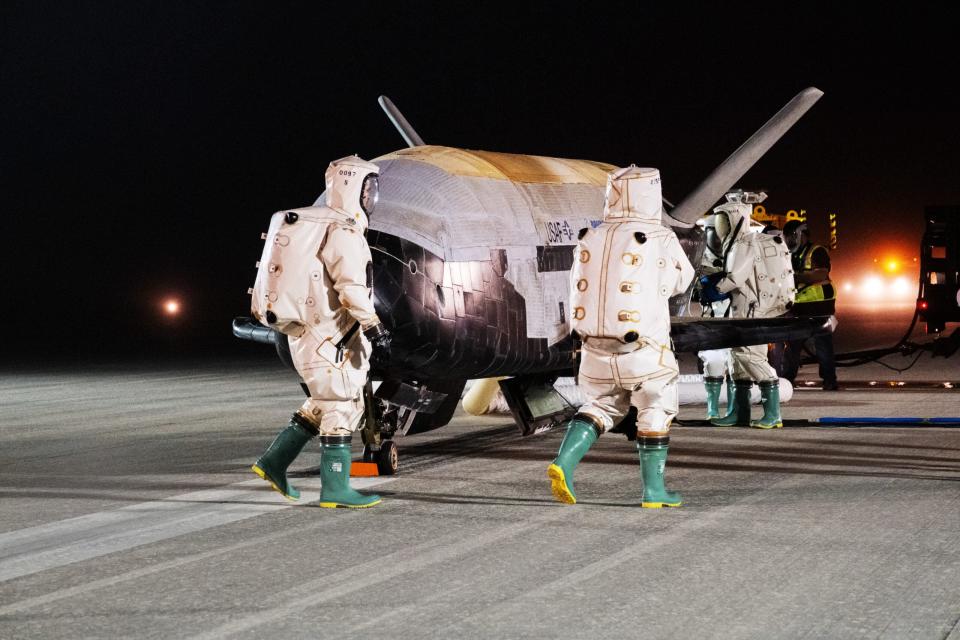
The X-37B at Kennedy Space Center, Florida. U.S. Air Force photo by Staff Sgt. Adam Shank
It’s possible that these “space domain awareness technologies” may refer to the surveillance of other objects in orbit, including those beyond the GEO belt. It could also relate to potential tests, or future plans, to have the X-37B approach other satellites in orbit for inspection or even manipulation or destruction. There have already been rumors that the X-37B may be intended to fulfill missions such as these, or that it might be intended as a space-based weapons platform.
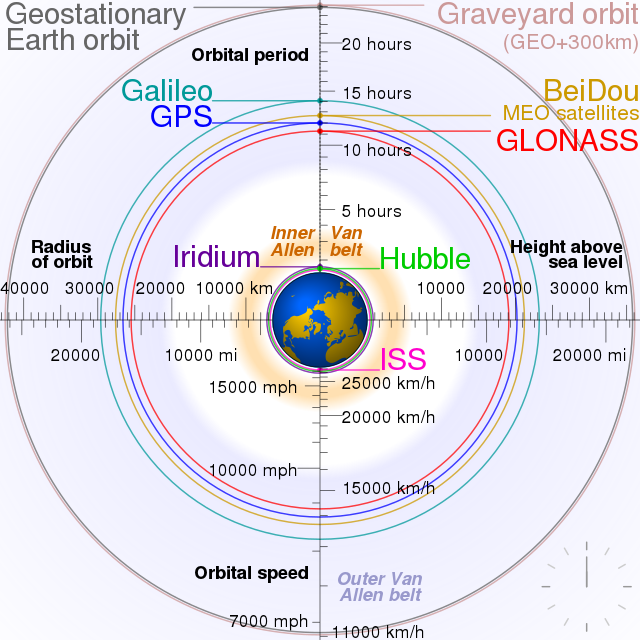
A schematic diagram providing a comparison between the orbits of some key satellites. cmglee/Wikicommons
The X-37B has previously been referred to as a component of an emerging Space Force “orbital warfare” remit. While details are extremely scarce, this mission falls within the remit of Space Delta 9, a unit known to be tasked with keeping track of potentially hostile activity in space, as well as deterring threats and even potentially defeating them.
Developments of this kind are of growing interest to the United States, especially in light of Chinese and Russian activities in space. Russia, for example, has a number of what it calls “space apparatus inspectors” in orbit, which the U.S. government and others warn the Kremlin could use to gather intelligence on other satellites or function as “killer satellites,” using various means to damage, disable, or destroy those targets.

A U.S. Defense Intelligence Agency diagram showing the various means by which one satellite might attack another. DIA
China, meanwhile, is busy with an apparently similar spaceplane project of its own, which you can read more about here. In May this year, the Chinese spaceplane is said to have returned to Earth after 276 days in orbit, a significant development for the Chinese space program, although well short of what the X-37B has achieved, in terms of duration.
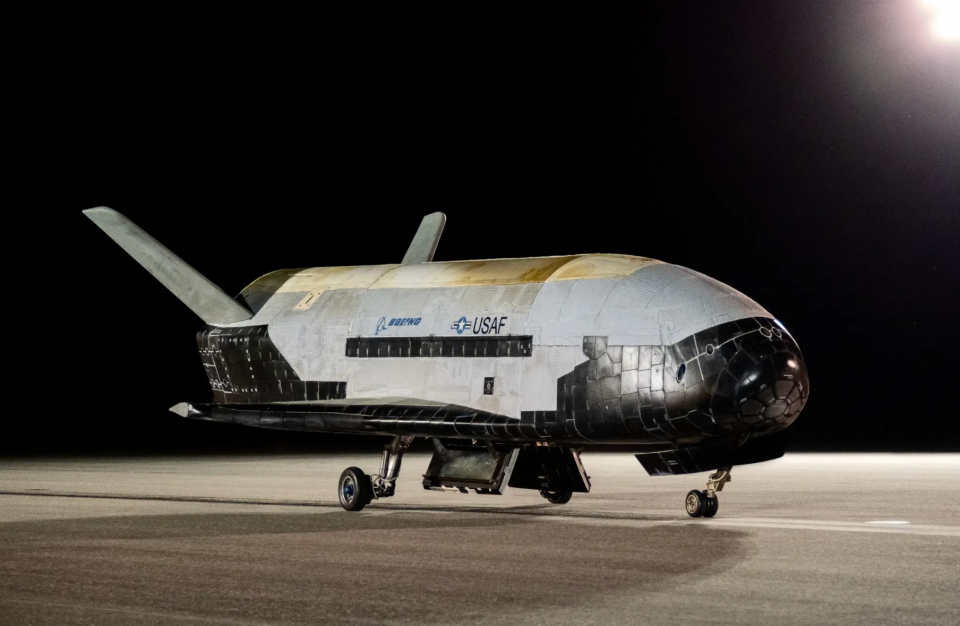
The X-37B rests on the flight line at Kennedy Space Center, Florida, on November 12, 2022, after it concluded its sixth successful mission that lasted 908 days. U.S. Air Force photo by Staff Sgt. Adam Shank
Whatever the types of payloads that the X-37B will carry once launched in December, the spaceplane will make use of a service module, in addition to its integral payload bay. Attached to the rear of the spaceplane, the service module provides extra space for payloads, meaning a wider range of experiments can be undertaken and cargoes carried.
The previous mission, X-37B Mission 6, was the first to introduce a service module, something you can read more about in our profile on it linked here.
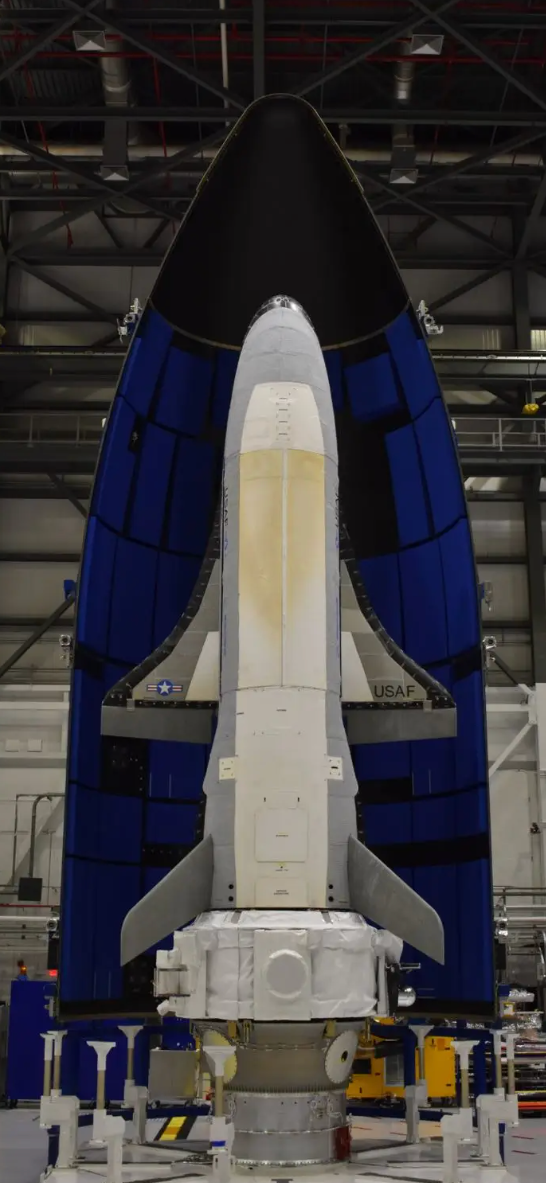
The X-37B ahead of its sixth mission, with the service module attached to its rear portion. USSF
A video showing the X-37B’s truckbed-sized main payload bay, like that found on the much larger NASA Space Shuttle:
https://twitter.com/DutchSpace/status/1305840741365678087
For X-37B Mission 6, payloads included the Naval Research Laboratory’s Photovoltaic Radio-frequency Antenna Module (PRAM) experiment, which transforms solar power into radio-frequency microwave energy; two previous NASA experiments looking at space effects on materials and seeds; as well as the FalconSat-8, a small satellite developed by the U.S. Air Force Academy and sponsored by the Air Force Research Laboratory. But these are just tertiary experiments as the core of the X-37B’s work is highly classified.
https://twitter.com/DutchSpace/status/1262112661040508928
X-37B Mission 6 launched in May 2020 on an Atlas V rocket and the spaceplane returned to Earth in November 2022, after 908 days in orbit — a new endurance record.
For now, as with all things X-37B-related, most aspects of the forthcoming seventh mission remain shrouded in secrecy. Whatever Mission 7 brings, in terms of experiments and flight profile, it will surely add another chapter to what is one of the most intriguing defense programs that we currently know about.
Contact the author: thomas@thedrive.com
A satellite's very tiny camera took a very blurry picture of Earth — and it's perfect
Monisha Ravisetti
Thu, November 9, 2023

A blurry image of a half shaded planet.
In a time when humanity has the means to procure almost unnaturally crisp images of the cosmos — from high-definition planetary portraits to massive deep space mosaics — there is something about the European Space Agency's new view of Earth that really gets me. It's blurry, the colors look kind of wrong, the planet isn't centered, half of the whole thing is shadowed, and honestly, it appears as though someone from the early 2000's took it with a flip phone.
Part of the allure is of course the fact that this image, according to ESA, was captured with a camera about the size of a coin's edge aboard a satellite made of three also-very-miniature boxes. The satellite is called TRISAT-R, and as the mission's project manager Iztok Kramberger said in the image's announcement, "this tiny camera measuring less than two cubic millimeters in size took a picture of an object measuring approximately one trillion cubic kilometers — our beautiful planet Earth — from thousands of kilometers away."
But beyond that, on a personal level, I think staring at this image makes our planet feel somehow more… real? It feels like a reminder that we literally exist on an object floating out there in the universe — a tangible orb in the tangible fabric of space-time that we can take a picture of. Not only does this frame highlight how our species has reached a point where a camera, smaller than a fingernail, can fly 6,000 kilometers (3,728 miles) upward and snap a visual of our entire world, but it also makes clear that this is, in fact, a picture. By contrast, the James Webb Space Telescope's infrared complexities add a layer of distance between us and the galaxies it images; the sharpness of Apollo 17's "Blue Marble" Earth portrait is incredible, but can make the scene feel a bit surreal.
On my own camera roll, I have hundreds of randomly blurry pictures in between those fit for an Instagram post. If, somehow, I could go to space and take a bunch of iPhone pictures of Earth, one of them would surely look something like this.
Related: These are the most detailed images of the moon ever taken on Earth
"If, somehow, I could go to space and take a bunch of iPhone pictures of Earth, one of them would surely look something like this."
If you're wondering why TRISAT-R took this image in the first place, the satellite, which is Slovenia's second such mission, flew out to medium-Earth orbit in 2022, bringing along some radiation-detection payloads and imaging devices. Basically, TRISAT-R's purpose is to help scientists study what goes on in parts of Earth's atmosphere called the Van Allen Radiation Belts.
The Van Allen Radiation Belts are zones in our planet's outer shell that host lots of charged particles — NASA compares them to "enormous donuts." The outer belt holds particles originating from the sun, while the inner belt tends to have particles resulting from what are known as cosmic rays, which zoom through space at nearly the speed of light. TRISAT-R's trajectory, ESA says, will take it right through the inner belt as well as through the heart of Earth's ionosphere, the boundary between our planet's atmosphere and the expanse of space. There are lots of charged particles around there, too.

The Blue Marble photo, captured by the crew of Apollo 17 on Dec. 7, 1972.

a blurry image of a half shaded planet.
And in addition to those radiation-detection payloads that'll study these supercharged regions around Earth, scientists armed TRISAT-R with, yes, cameras. Alongside the satellite, the TRISAT-R team sent up super small cameras made with clear borosilicate glass lenses (a highly durable form of glass) mounted directly onto 320x320 pixel image sensors, according to the statement. That's where we get our wonderfully faulted view.
Related Stories:
— Earth looks stunning in this 1st full view from the NOAA-21 satellite (photos)
— The 1st photo of Earth from Europe's powerful new satellite is amazing
— Satellite sees annular solar eclipse from 1 million miles away (photo)
"The resulting picture of Earth is very low resolution as these highly miniaturized cameras were not intended to perform terrestrial imaging," Kramberger said. Plus, the researcher continued, the satellite employs rather weak "magnetorquers" that push against Earth's magnetic field for its attitude control, so precision pointing is difficult to achieve.
Kramberger explains that the team's main interest with regard to imagery was to capture examples of the so-called "Black Sun effect." This effect basically happens when over-saturation of pixels in an image can cause very bright areas to appear dark.
"We have succeeded in these investigations, but have also been lucky enough to acquire images like these."
Watch NASA’s bizarre and bulbous Super Guppy cargo plane touch down in Alabama
Andrew Paul
Thu, November 9, 2023

Aboard the Super Guppy this time was a heat shield used during last year's Artemis I mission.
After over half a century of loyal service, the world’s last remaining Super Guppy aircraft continues to dutifully transport NASA’s gigantic rocket parts in its cavernous, hinged cargo bay. On Tuesday, the Huntsville International Airport posted a video and accompanying images to social media of the rotund plane arriving from Kennedy Space Center. Perhaps somewhat unsurprisingly, it sounds like a prop plane of that size can make a huge, rich racket on the tarmac.
https://youtu.be/dkInIl6zVfM
[Related: Artemis II lunar mission goals, explained.]
Aboard the over 50-ton (when empty), turboprop plane this time around was the heat shield that protected last year’s Artemis I Orion spacecraft. The vital rocketry component capable of withstanding 5,000 degrees Fahrenheit resided in the Super Guppy’s 25-foot tall, 25-foot wide, 111-foot long interior during a nearly 690-mile journey to the Alabama airport, after which it was transported a few miles down the road to the Marshall Space Flight Center. From there, a team of technicians will employ a specialized milling tool to remove the heat shield’s protective Avcoat outer layer for routine post-flight analysis, according to NASA.
The Super Guppy is actually the third Guppy iteration to lumber through the clouds. Based on a converted Boeing Stratotanker refueling tanker and designed by the now defunct Aero Spacelines during the 1960s, an original craft called the Pregnant Guppy was supplanted by its larger Super Guppy heir just a few years later. This updated plane included an expanded cargo bay, alongside an incredibly unique side hinge that allows its forward section to open like a pocket watch. A final Super Guppy Turbine debuted in 1970, and remained in use by NASA for over 25 years. In 1997, the agency purchased one of two newer Super Guppy Turbines built by Airbus. This Guppy is the current and only such hefty boy gracing the skies. With its bulky profile, the Super Guppy’s travel specs are pretty impressive—it’s capable of flying as high as 25,000 feet at speeds as fast as 250 nautical miles per hour.
[Related: NASA’s weird giant airplane carried the future of Mars in its belly.]
Last PopSci checked in on the Super Guppy’s journeys was back in 2016, when it transported an Orion crew capsule potentially destined for a much further trip than the Artemis missions’ upcoming lunar sojourns—Mars. According to Digital Trends, the Super Guppy’s next flight could occur sometime next year ahead of NASA’s Artemis II human-piloted lunar flyby.
“Although much of the glory of America’s space program may be behind it, the Super Guppy continues to be one of the only practical options for oversized cargo and stands ready to encompass a bigger role in the future,” reads a portion of NASA’s official description.
Until then, feel free to peruse the official, 74-page Super Guppy Transport User’s Guide.
No comments:
Post a Comment